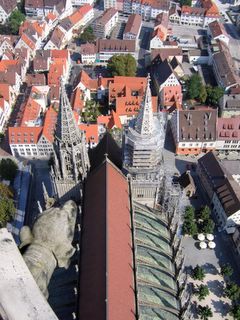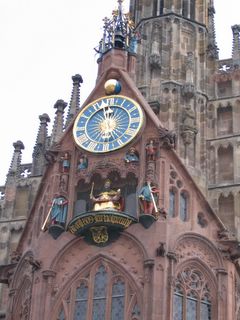Tuesday, October 18, 2005

When we were leaving Ulm to head o our hotel, we realized we parked across the street from the home of Ulm's most famous resident - Albert Einstein! Ulm is a beautiful city with so much charm!

We walked along the old town wall and follwed it to the small part of town called Fisherman's Quarter - or the Little Venice. It is full of picturesque corners, tight alleys and beautiful half timbered houses. The one in the picture is actually in the Guiness Book of World Records as the world's most crooked house - The Scheiffes Haus, built in 1443. Today it houses a hotel.

This is the Rathaus - (Old Town Hall). The facades are decorated with paintings about human virtue and vice. The astronomical clock dates back to 1520. Unfortunately, in 1944 the picturesque town hall was destroyed by bombs. It was rebuilt to original plans in the year 1951.

The church was started in the year 1377!! It was built and finally finished after several different periods in the early 1800s. It would have been a real tragedy if this would have been bombed in the war, but thankfully the entire church was spared.

Here is the view from the top of the spire. It was beautiful!! On a day without haze you are supposed to be able to see the alps in the south! It took awhile to reach but the view was so worth the climb!

If you click and zoom in on the Cathedral, we climbed up all the way to where the ring is at the top in the sunlight!! Oh yes - all the way up THERE!
Sunday, September 4, 2005

This morning we headed down to the city of Ulm with our friends the Derners. Ulm is a charming city on the Danube River in Southern Germany. Jake is standing in front of the Ulm Cathedral. This is the world's tallest church with the spire reaching 530 feet! So what did we do? We climbed it to the top!!!
Monday, October 17, 2005

This was our last stop of our trip. There is very little information about this area of Nuremberg unless you are willing to find it on your own. Not a part of history that the German's are proud of, but it is history nontheless. We had a great time on our Poland/Nuremberg trip!

It is really difficult to explain how strange it was to know that we were standing right where Hitler stood. This is a picture from the Rally that took place here.

From this rostrum, Hitler delivered stirring speeches to thousands of party members. The Zeppelin Grandstand was constructed under Albert Speer's management between 1934 and 1937. Hitler intended for the buildings at the Party Rally Grounds to stand for thousands of years, similar to the great cathedrals of the past. Four days after the fall of Nuremberg, the US Army blew up the swastika which had been installed at the center of the Grandstand. In 1967 the colonnade of the Grandstand was blown up because it had become unstable. The height of the side towers was also reduced by half in the 1970s.

This is the Nazi Rally Stand. If you click on the picture to enlarge you will see Jake standing exactly where Hitler stood giving his famous rally speeches at the Rally in Nuremberg.

The Nuremberg Trials is the general name for two sets of trials of Nazis involved in World War II and the Holocaust . The trials were held in the German city of Nuremberg from 1945 to 1949 at the Nuremberg Palace of Justice . The first and most famous of these trials was the Trial of the Major War Criminals Before the International Military Tribunal or IMT, which tried twenty-four of the most important captured (or still believed to be alive) leaders of Nazi Germany. It was held from November 20 , 1945 to October 1 , 1946 . The second set of trials of lesser war criminals was conducted under Control Council Law No. 10 at the U.S. Nuremberg Military Tribunals (NMT), including the famous Doctors' Trial .

Recognize the building behind us? It is the courthouse where the famed Nuremberg Trials after WWII took place.

Behind Kaitlyn in this picture is Nuremberg's star attraction - the Gothic Schoner Brunnen (Beautiful Fountain). The original was probably erected around 1385 but replaced in the 20th century with a replica. It's spire is 62feet high and stands in the center of an octagonal pool. It is adourned with statues of Electors and of Jewish and Christian heroes. The pool is surrounded by a Renaissance grill that includes a brass ring.The legend is that if you turn the ring on the grill 3 times, your wish will come true - both Kaitlyn and Jake turned the brass ring!

Each day at noon the clock displays a procession of Elders paying homage to the Emperor. The inside of church was fairly simple and unfortunately, most of the church, like 90% of the town, was destroyed during bombing raids from WWII.

From the castle we walked through town to the Haupmarkt where at the end of the square is the Frauenkirche. The church dates from 1352-1358. Above the richly decorated vestibule is the gable that contains a clock installed in 1509.

This morning our first stop was the castle! This picture is taken inside the courtyard of the imperial castle. In the background is the Sinwellturn, the round tower, dating from the 12th century.

Last night after a quick swim at the hotel pool, we all had a great night's sleep! Our room was great - we had a small suite and it was great!

The building on the right is Durer's house and the building on the left is the restaurant where we ate our dinner.

It was time to get something to eat so we ate at a nice restaurant and ate some traditional German fare. DInner was deliciuos and just what we all needed! The interesting thing is that when we found some pictures of Nuremberg after WWII, we saw a picture of of this exact spot.

This is a picture of one of Durer's most famous pieces - it is called The Praying Hands. There is a beautiful story behind the painting. They are actually his brother's hands, and the story can be read here: http://www.moytura.com/reflections/prayinghands.htm
Tuesday, August 23, 2005

After a few hours driving from Poland back into Germany, we checked into our hotel, TipTop Burghotel in Nuremberg and then we were off exploring the city. Our hotel was right around the corner from the Kaiserburg - the city's castle. Just below the castle is this building in the picture - Albrecht Durer's house. Durer is one of the most famous painters of the Renaissance era. He lived here from 1509 until his death in 1528.





